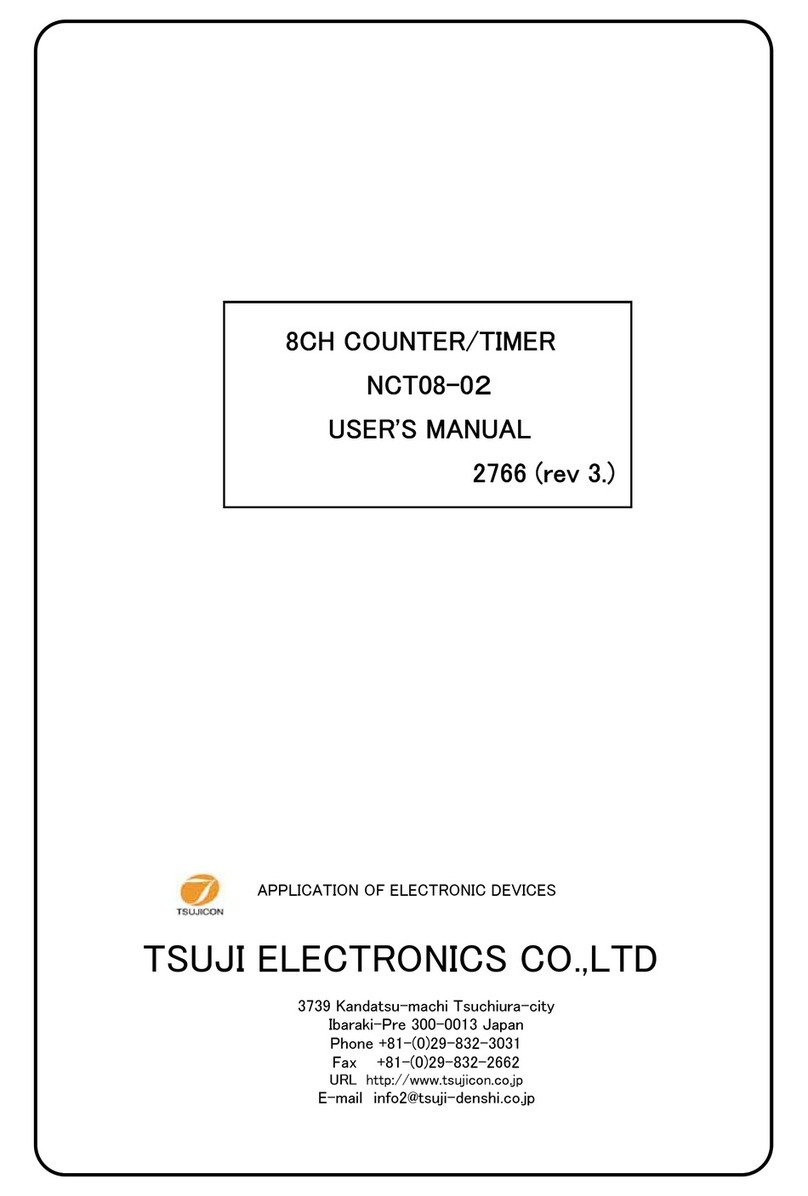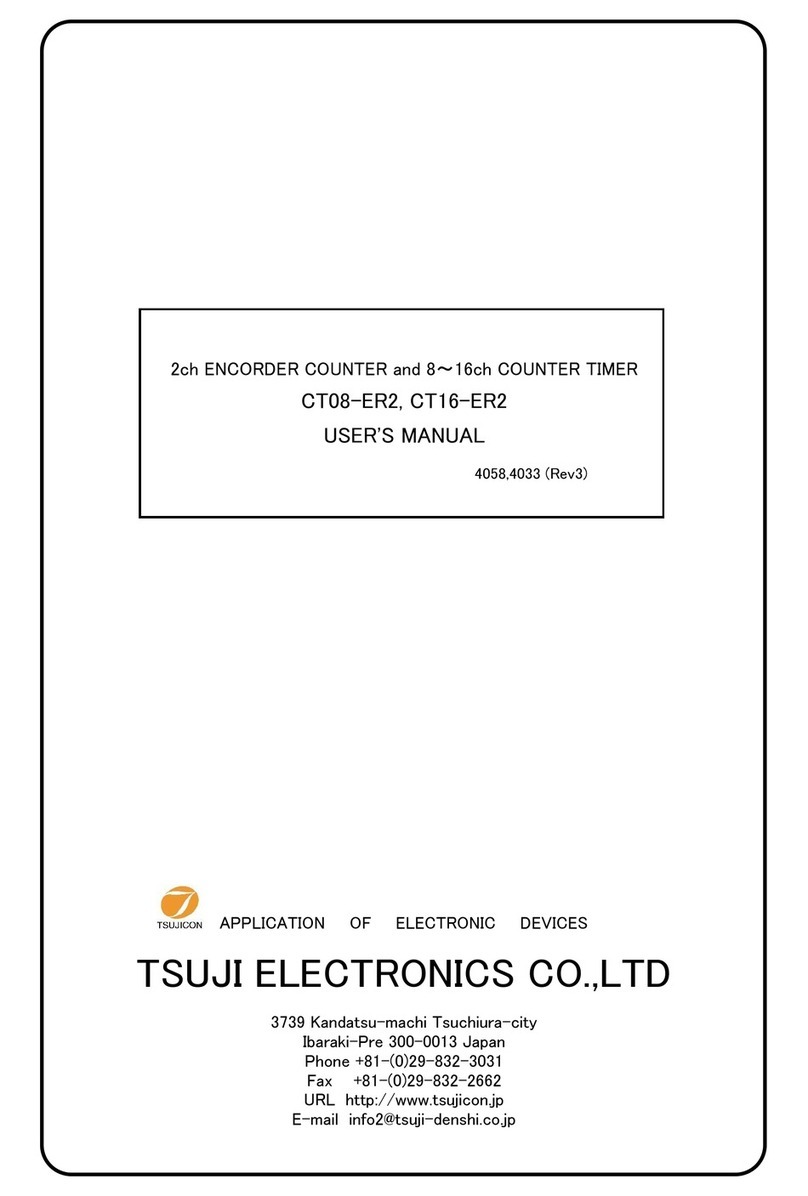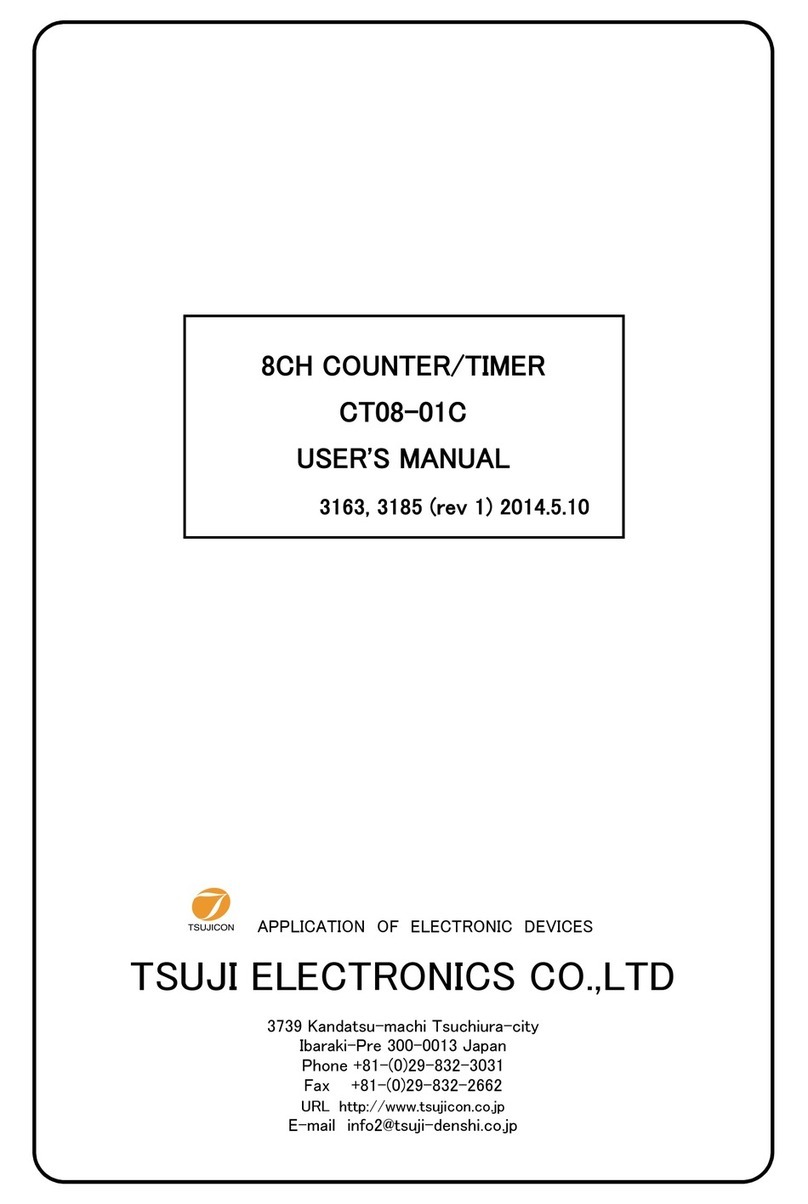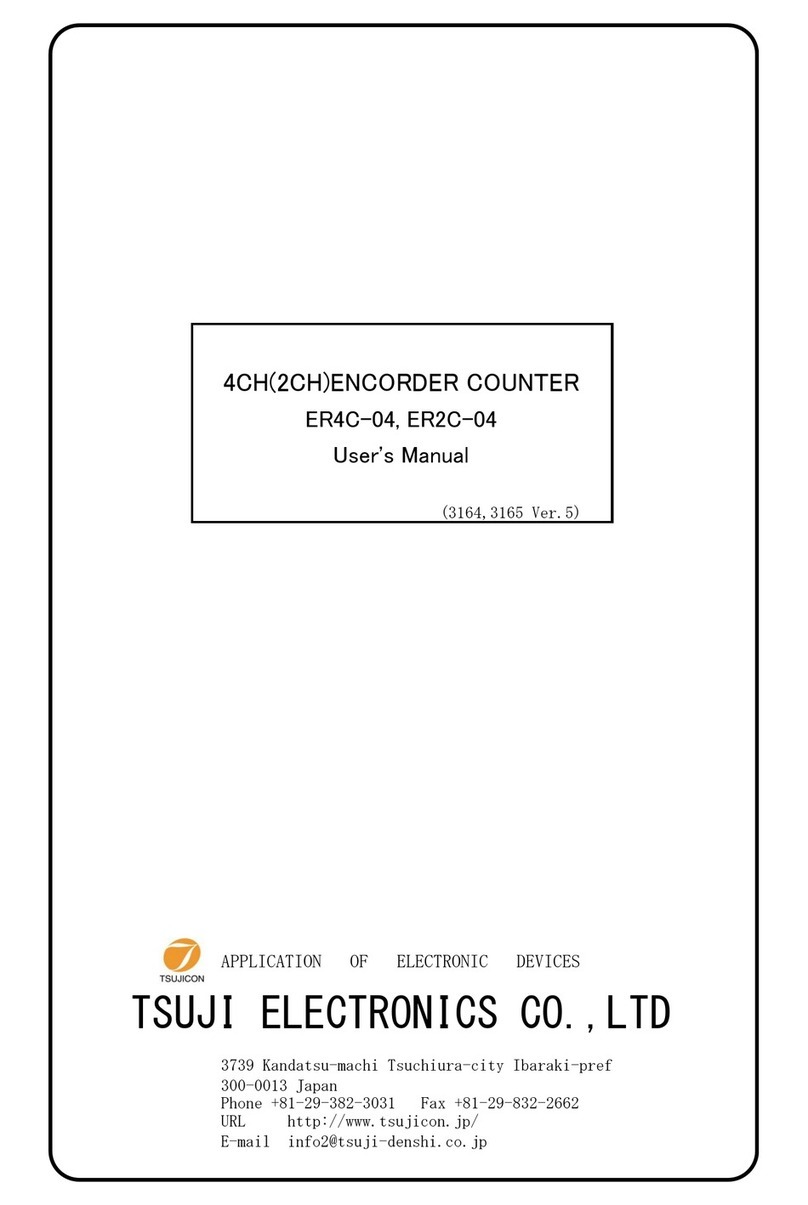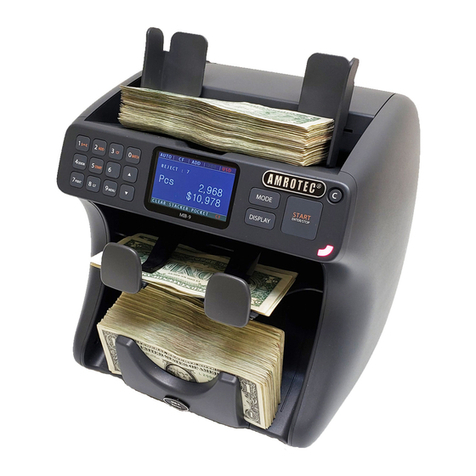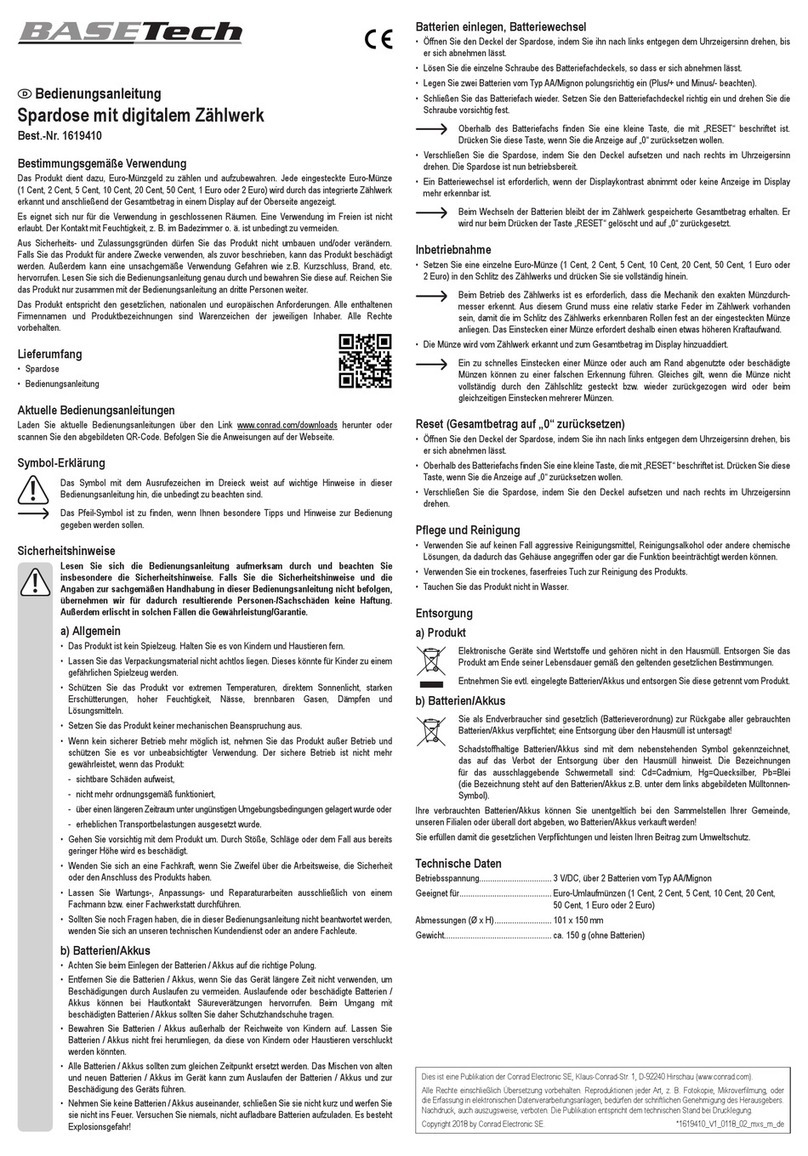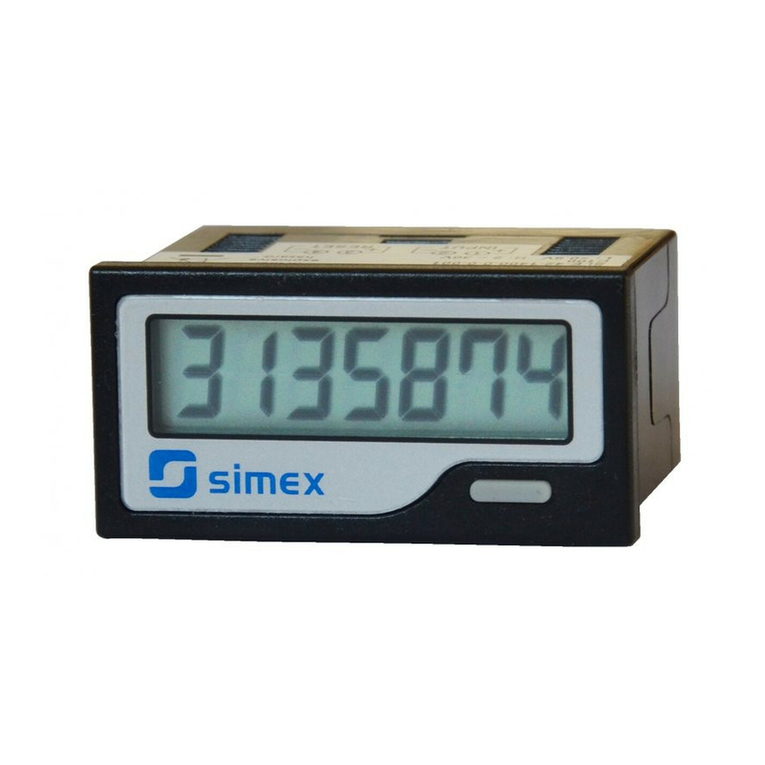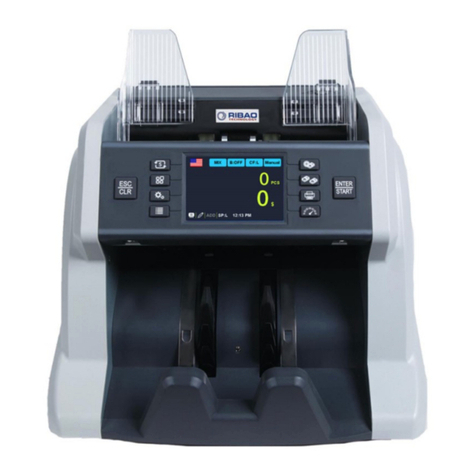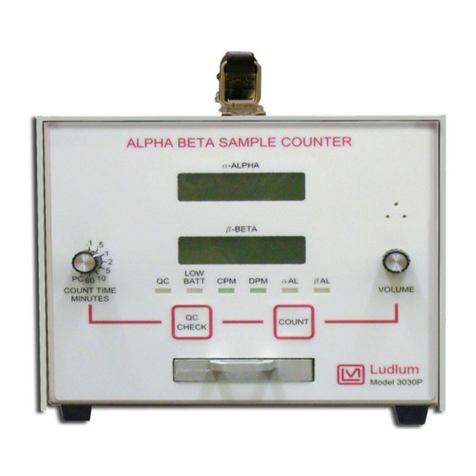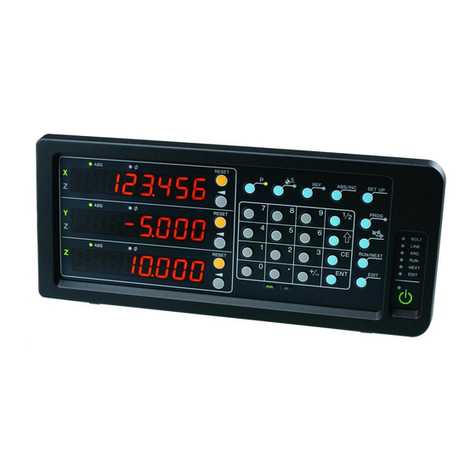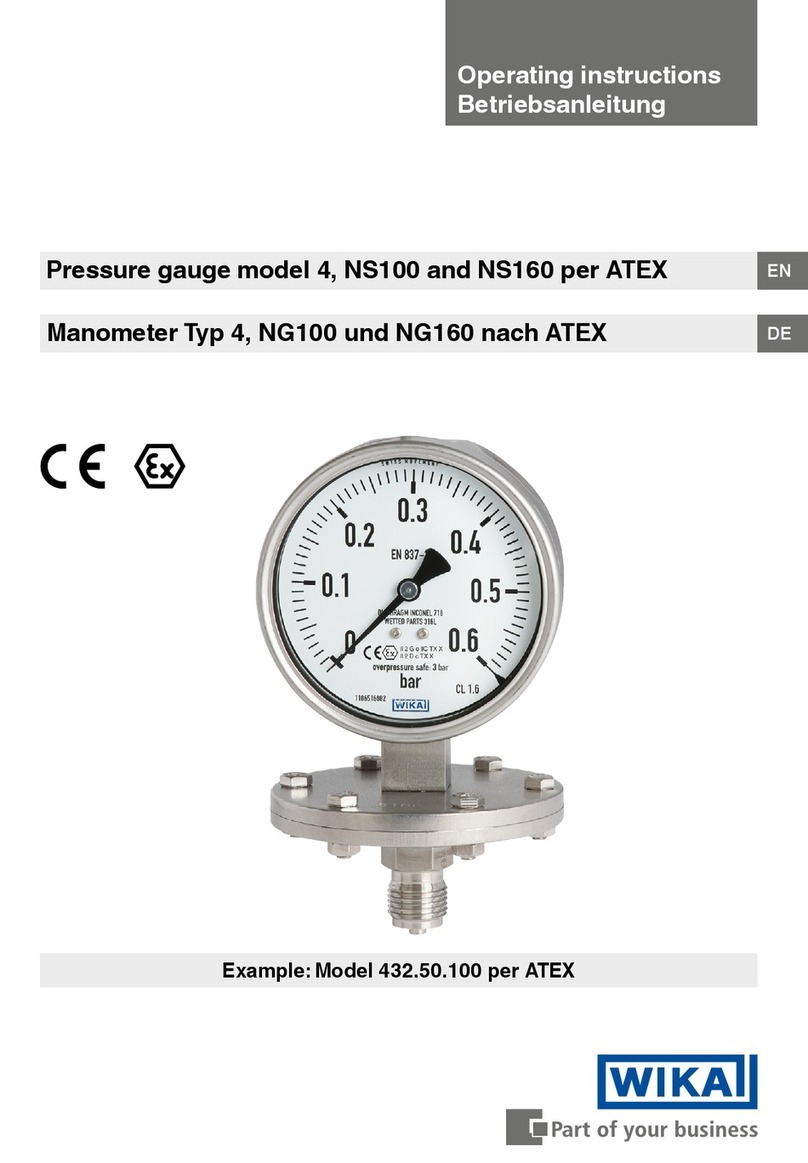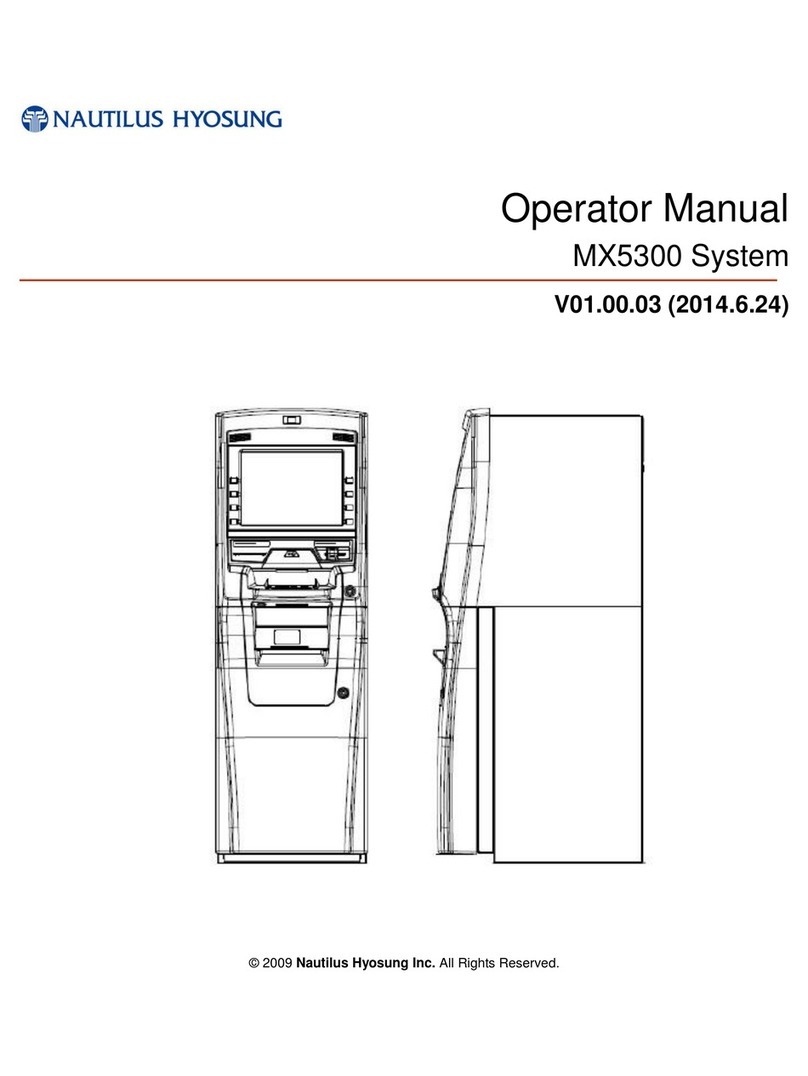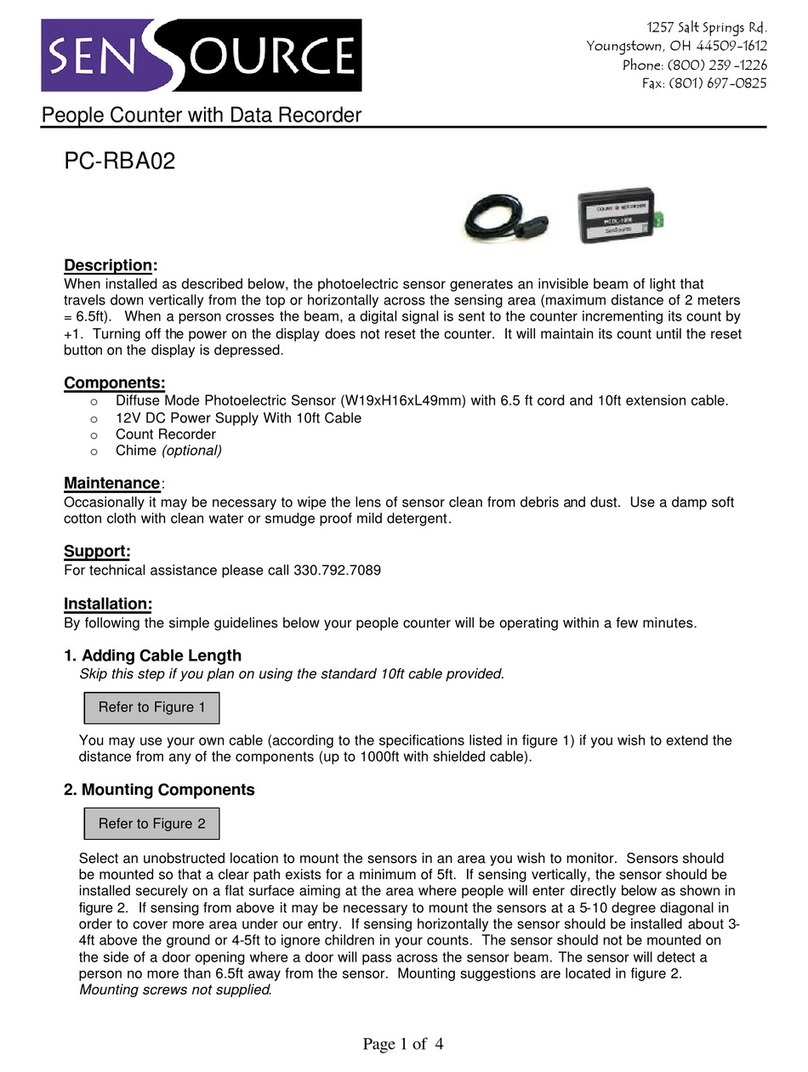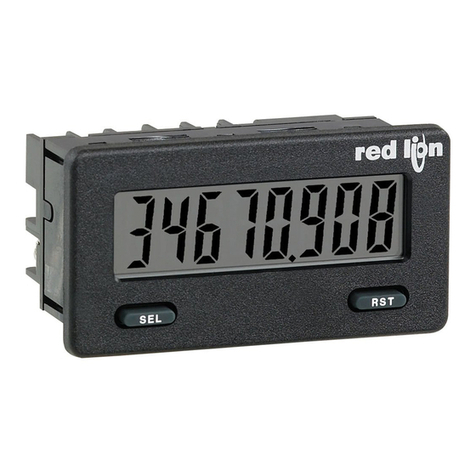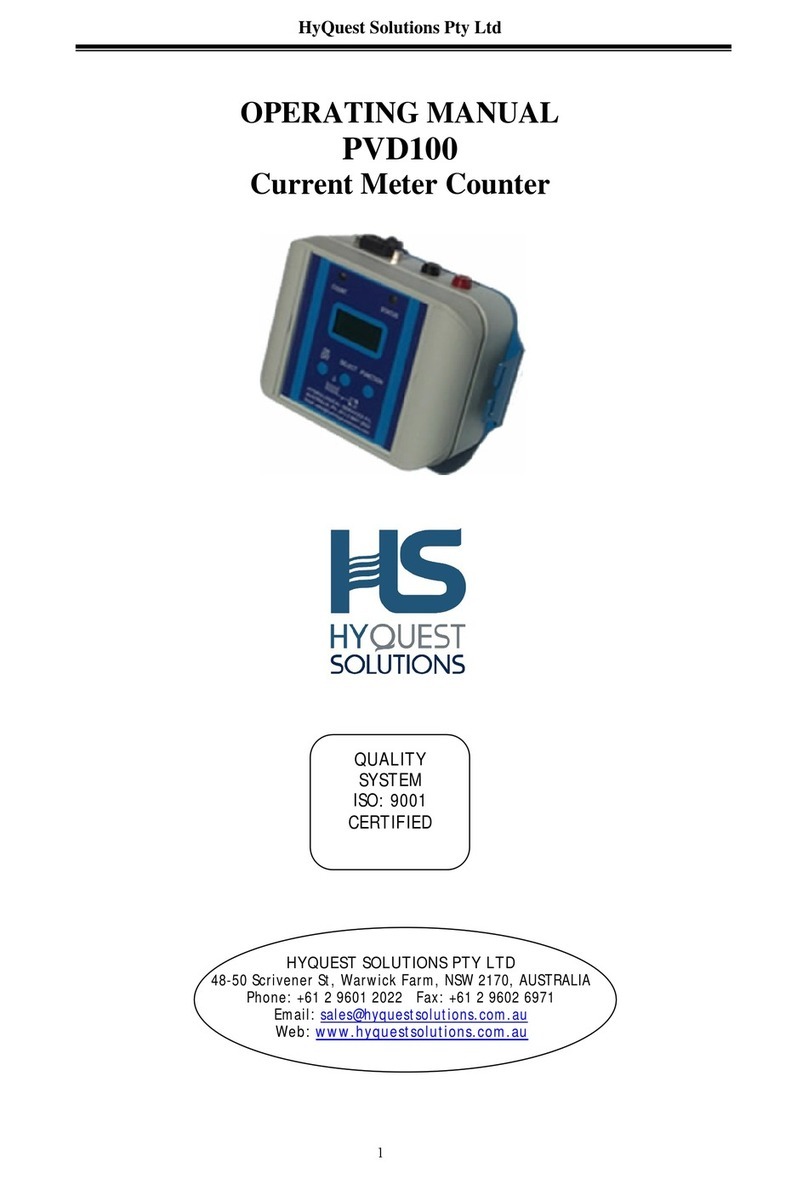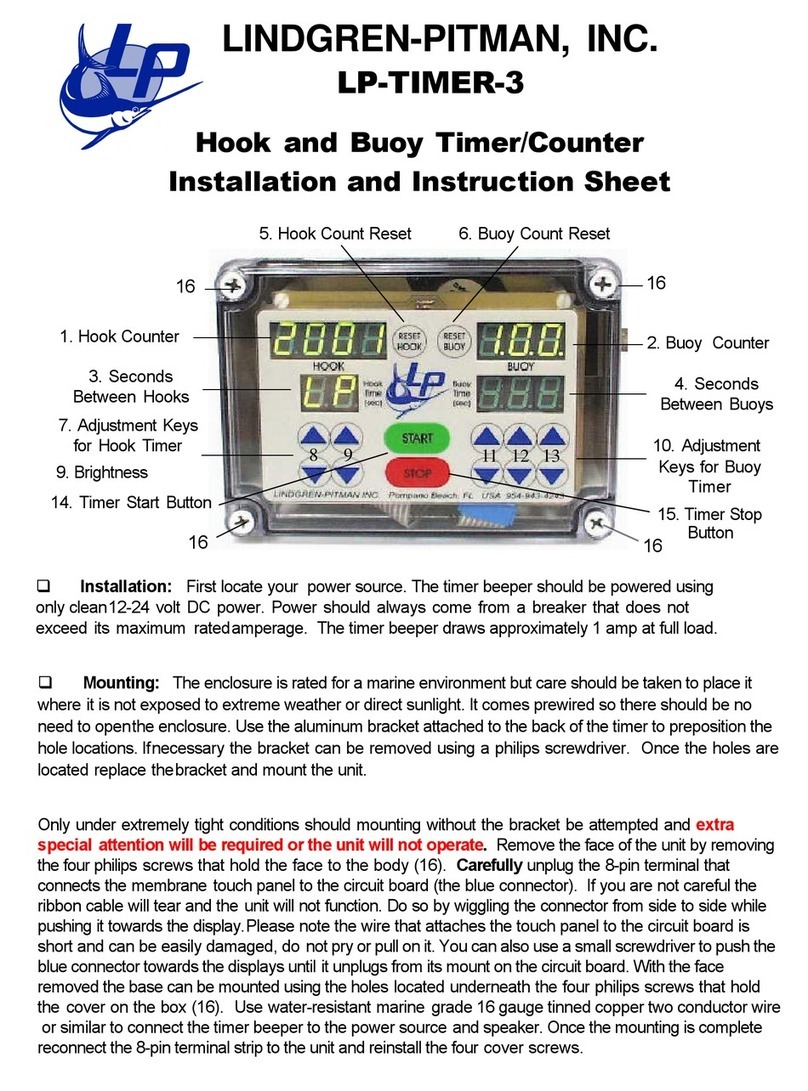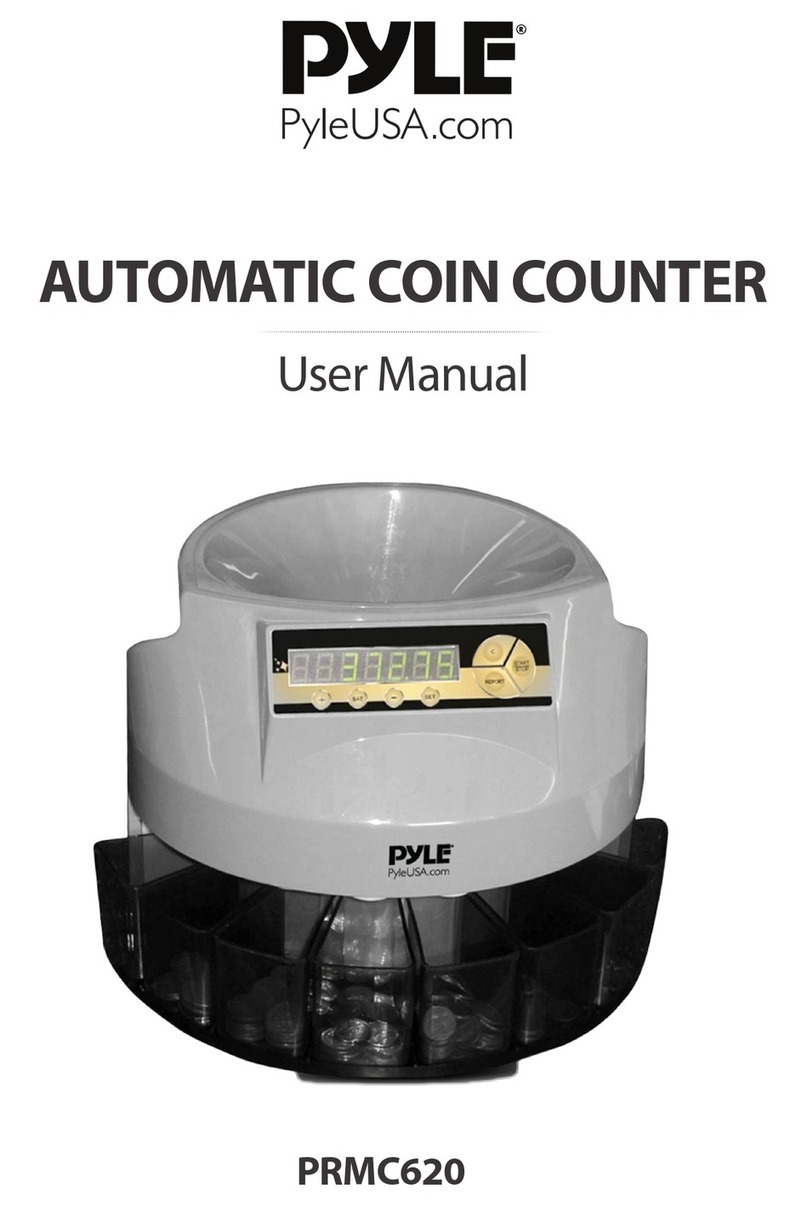TSUJI ELECTRONICS CT08-01B User manual

E-mail info2@tsuji-denshi.co.jp
APPLICATION OF ELECTRONIC DEVICES
3092,3114 (rev 3) 2013.5.13
Ibaraki-Pre 300-0013 Japan
Phone +81-(0)29-832-3031
3739 Kandatsu-machi Tsuchiura-city
TSUJI ELECTRONICS CO.,LTD
Fax +81-(0)29-832-2662
8CH COUNTER/TIMER
CT08-01B
USER'S MANUAL
URL http://www.tsujicon.co.jp

CT08-01B Command List(Available LAN,USB)
The command that is written by blue is available for V1.02 or later version.
See the section 5. Firmware Update regarding firmware update.
COMMAND FUNCTION DETAIL
ALM? alarm read read out the cause of overflow
CLAL clear all clear timer and 8 channel counters
CLPC clear preset counter clear preset counter (CH7)
CLTM clear timer clear timer
CLCTxx clear counter xx clear counter channel xx xx:00-07
CLCTxxyy clear counter xx to yy clear counter channel xx to yy xx,yy:00-07
CPR? counter preset data read read out preset counter data
Reply: 8 digits in decimal number (Kcts unit)
(example:00010000)
CPRF? counter preset data read read out preset counter data
Reply: 8 digits in decimal number (cts unit)
(example:00010000)
CTR?xx counter xx read read out channel xx counter xx:00-07
Reply: 10 digits in decimal number
CTRH?xx counter xx read read out channel xx counter xx:00-07
Reply: 8 digits in hex
CTR?xxyy counter xx to yy read read out channel xx counter xx,yy:00-07
Reply: 10 digits in dec (separated by space)
CTRH?xxyy counter xx to yy read read out from channel xx to yy counter
xx,yy:00-07 Reply: 8 digits in hex (separated by space)
DSAS disable auto stop disable automatic stop until using STOP command
ENCS enable counter stop enable counter stop
ENTS enable timer stop enable timer stop
MOD? mode read read out counter mode
RDAL? read all counter and timer read out all counter and timer
Reply: 10 digits in dec
RDALH? read all counter and timer read out all counter and timer
Reply: 8 digits in hex
SCPRdddd・・・・ set counter preset data set preset data to counter (Kcts unit)
SCPRFdddd・・・・ set counter preset data set preset data to counter (cts unit)
TPR? timer preset data read read out preset timer data (ms unit)
TPRF? timer preset data read read out preset timer data (μs unit)
STOP stop counter deactivate counting action
STPRdddd・・・・ set preset counter to dddd・・・・ set preset timer value (ms unit)
STPRFdddd・・・・ set preset counter to dddd・・・・ set preset timer value (μs unit)
STRT start counter start counting action
TMR? timer read read out timer value Reply: 10 digits in dec
TMRH? timer read read out timer value Reply: 10 digits in hex
VER? version information read read out software version information
VERH? hardware version information read out hardware version information
REST reset and start set the unit restart (It's same as power on sequence)
FROM? using rom number read read out program ROM number inside
FROM0,FROM1 choose rom set program ROM number to activate
FLG?x read internal flag read out internal state flag inside
2/28

(Available for firmware V1.04 or later.)
Command for All reply mode
ALL_REP? read all reply mode setting Confirm "all reply mode" is active or not.
ALL_REP_EN All reply mode enable Reply is "OK" or "NG" even if the command
doesn't require a reply.
ALL_REP_DS All reply mode disable No reply, if the command doesn't require
a reply. (the same as before)
Store data commands for synchronous gate signal and timer clock
Preparation of data acquisition commands
CLGSDN Clear Gate Synchronous clear current data acquisition address
Data Number (set data address to zero)
CLGSAL Clear Gate Synchronous clear current data address and all memory data
acquired All data (set data address to zero, clear all memory data)
GSDNddd・・・ Gate Synchronous Data input gate synchronous data acquisition
acquisition data Number set data address
GSDN? Gate Synchronous Data read out gate synchronous data acquisition
acquisition data Number read data address reply : 0 ~ 9999
GSEDddd・・・ Gate Synchronous acquisition input gate synchronous data acquisition end data
End data Number set address. (after end address, acquisition stop.)
GSED? Gate Synchronous acquisition read gate synchronous data end address
End data Number read reply : 0 ~ 9999
Synchronous GATE signal data acquisition commands
GSTRT Gate synchronous data start gate synchronous data acquisition
acquisition START (just after turn on power, it's stop condition)
GESTRT Gate Edge synchronous data start gate edge synchronous data acquisition
acquisition STaRT (just after turn on power, it's stop condition)
Synchronous internal clock data acquisition commands
GTRUNddd・・・ Gate Timer synchronous input synchronous timer data RUN time
RUN time (μs units)
GTRUN? Gate Timer synchronous read out synchronous timer data RUN time
RUN time read
GTOFFddd・・・ Gate Timer synchronous input synchronous timer data OFF time
OFF time (μs units)
GTOFF? Gate Timer synchronous read out synchronous timer data OFF time
OFF time read
GTSTRT Gate Timer synchronous data start internal clock synchronous data acquisition
acquisition START (Just after turn on power, it's stop condition)
3/28

Synchronous data acquisition common commands
STOP gate synchronous data stop gate synchronous data acquisition
acquisition STOP
GSTS? Gate synchronous data read out the status of gate synchronous data
acquisition Status read acquisition
GSDAL? Gate synchronous data read out all gate synchronous data
acquisition all data read
GSDALH? Gate synchronous data read out all gate synchronous data
acquisition all data read Reply: 8 digits in hex
GSDRD?xxxxyyyy Gate synchronous data read read gate synchronous data from xxxx to yyyy
from xxxx to yyyy (xxxx,yyyy:0000~9999)
GSDRDH?xxxxyyyy Gate synchronous data read read gate synchronous data from xxxx to yyyy
from xxxx to yyyy (xxxx,yyyy:0000~9999) Reply: 8 digits in hex
GSCRD? Gate synchronous data read read gate synchronous data from xxxx to yyyy
uvwxxxxyyyy from xxxx to yyyy at ch u to v at ch u to v w:1 with timer Reply: dec
GSDRDH? Gate synchronous data read read gate synchronous data from xxxx to yyyy
uvwxxxxyyyy from xxxx to yyyy at ch u to v at ch u to v w:1 with timer Reply: hex
4/28

CONTENTS
1.Specification ・・・・・・・・・・・・・・・・・・・・・・・・・・・・・・・・・・・・・・・・・・・・・・・・・・・・・・・・・・・・・・・・・・ 6
1-1.Abstract
・・・・・・・・・・・・・・・・・・・・・・・・・・・・・・・・・・・・・・・・・・・・・・・・・・・・・・・・・・・・・・・・・・
6
1-2.Appearance
・・・・・・・・・・・・・・・・・・・・・・・・・・・・・・・・・・・・・・・・・・・・・・・・・・・・・・・・・・・・・・・・・・
6
1-3.Block diagram
・・・・・・・・・・・・・・・・・・・・・・・・・・・・・・・・・・・・・・・・・・・・・・・・・・・・・・・・・・・・・・・・・・
7
2.Before using ・・・・・・・・・・・・・・・・・・・・・・・・・・・・・・・・・・・・・・・・・・・・・・・・・・・・・・・・・・・・・・・・・・ 8
2-1.Select input signal level for count
・・・・・・・・・・・・・・・・・・・・・・・・・・・・・・・・・・・・・・・・・・・・・・・・・・・・・・・・・・・・・・・・・・
8
2-2.Setting LAN communication
・・・・・・・・・・・・・・・・・・・・・・・・・・・・・・・・・・・・・・・・・・・・・・・・・・・・・・・・・・・・・・・・・・
8
2-2-1.Preparation for setting
・・・・・・・・・・・・・・・・・・・・・・・・・・・・・・・・・・・・・・・・・・・・・・・・・・・・・・・・・・・・・・・・・・
8
2-2-2.Changing setting condition for setting
・・・・・・・・・・・・・・・・・・・・・・・・・・・・・・・・・・・・・・・・・・・・・・・・・・・・・・・・・・・・・・・・・・
9
2-2-3.Turn back PC set data
・・・・・・・・・・・・・・・・・・・・・・・・・・・・・・・・・・・・・・・・・・・・・・・・・・・・・・・・・・・・・・・・・・
11
2-2-4.Connection test
・・・・・・・・・・・・・・・・・・・・・・・・・・・・・・・・・・・・・・・・・・・・・・・・・・・・・・・・・・・・・・・・・・
11
2-3.Setting USB communication
・・・・・・・・・・・・・・・・・・・・・・・・・・・・・・・・・・・・・・・・・・・・・・・・・・・・・・・・・・・・・・・・・・
11
2-3-1.Preparations for setting
・・・・・・・・・・・・・・・・・・・・・・・・・・・・・・・・・・・・・・・・・・・・・・・・・・・・・・・・・・・・・・・・・・
11
2-3-2.Connecting test
・・・・・・・・・・・・・・・・・・・・・・・・・・・・・・・・・・・・・・・・・・・・・・・・・・・・・・・・・・・・・・・・・・
11
2-4.Connect communication cables
・・・・・・・・・・・・・・・・・・・・・・・・・・・・・・・・・・・・・・・・・・・・・・・・・・・・・・・・・・・・・・・・・・
12
2-4-1.Connect communication cables
・・・・・・・・・・・・・・・・・・・・・・・・・・・・・・・・・・・・・・・・・・・・・・・・・・・・・・・・・・・・・・・・・・
12
2-4-2.Connect count signal
・・・・・・・・・・・・・・・・・・・・・・・・・・・・・・・・・・・・・・・・・・・・・・・・・・・・・・・・・・・・・・・・・・
12
2-4-3.Start signal (TTL positive logic)
・・・・・・・・・・・・・・・・・・・・・・・・・・・・・・・・・・・・・・・・・・・・・・・・・・・・・・・・・・・・・・・・・・
12
2-4-4.Stop signal (TTL positive logic)
・・・・・・・・・・・・・・・・・・・・・・・・・・・・・・・・・・・・・・・・・・・・・・・・・・・・・・・・・・・・・・・・・・
12
2-4-5.Gate signal (TTL positive logic)
・・・・・・・・・・・・・・・・・・・・・・・・・・・・・・・・・・・・・・・・・・・・・・・・・・・・・・・・・・・・・・・・・・
12
2-4-6.Monitor out signal (In counting, TTL positive logic)
・・・・・・・・・・・・・・・・・・・・・・・・・・・・・・・・・・・・・・・・・・・・・・・・・・・・・・・・・・・・・・・・・・
12
3.Communication commands
・・・・・・・・・・・・・・・・・・・・・・・・・・・・・・・・・・・・・・・・・・・・・・・・・・・・・・・・・・・・・・・・・・
13
3-1.Communication commands
・・・・・・・・・・・・・・・・・・・・・・・・・・・・・・・・・・・・・・・・・・・・・・・・・・・・・・・・・・・・・・・・・・
・・・・・・・・・・・・・・・・・・・・・・・・・・・・・・・・・・・・・・・・・・・・・・・・・・・・・・・・・・・・・・・・・・
13
3-2.Read-out commands for counter set and the status of setting
・・・・・・・・・・・・・・・・・・・・・・・・・・・・・・・・・・・・・・・・・・・・・・・・・・・・・・・・・・・・・・・・・・
13
3-2-1.Stop enable by count value
・・・・・・・・・・・・・・・・・・・・・・・・・・・・・・・・・・・・・・・・・・・・・・・・・・・・・・・・・・・・・・・・・・
13
3-2-2.Stop enable by timer value
・・・・・・・・・・・・・・・・・・・・・・・・・・・・・・・・・・・・・・・・・・・・・・・・・・・・・・・・・・・・・・・・・・
13
3-2-3.Stop disable by counter timer
・・・・・・・・・・・・・・・・・・・・・・・・・・・・・・・・・・・・・・・・・・・・・・・・・・・・・・・・・・・・・・・・・・
13
3-2-4.Inquiry of action mode
・・・・・・・・・・・・・・・・・・・・・・・・・・・・・・・・・・・・・・・・・・・・・・・・・・・・・・・・・・・・・・・・・・
13
3-2-5.Setting and readout of preset counter
・・・・・・・・・・・・・・・・・・・・・・・・・・・・・・・・・・・・・・・・・・・・・・・・・・・・・・・・・・・・・・・・・・
14
3-2-6.Setting and readout of preset timer
・・・・・・・・・・・・・・・・・・・・・・・・・・・・・・・・・・・・・・・・・・・・・・・・・・・・・・・・・・・・・・・・・・
14
3-3.Commands of counter operation
・・・・・・・・・・・・・・・・・・・・・・・・・・・・・・・・・・・・・・・・・・・・・・・・・・・・・・・・・・・・・・・・・・
14
3-3-1.Counter start
・・・・・・・・・・・・・・・・・・・・・・・・・・・・・・・・・・・・・・・・・・・・・・・・・・・・・・・・・・・・・・・・・・
14
3-3-2.Counter stop
・・・・・・・・・・・・・・・・・・・・・・・・・・・・・・・・・・・・・・・・・・・・・・・・・・・・・・・・・・・・・・・・・・
14
3-4.Read-out and clear commands for counter and timer
・・・・・・・・・・・・・・・・・・・・・・・・・・・・・・・・・・・・・・・・・・・・・・・・・・・・・・・・・・・・・・・・・・
15
3-4-1.Read-out and clear commands for all counter and timer
・・・・・・・・・・・・・・・・・・・・・・・・・・・・・・・・・・・・・・・・・・・・・・・・・・・・・・・・・・・・・・・・・・
15
3-4-2.Read-out and clear commands for all counter
・・・・・・・・・・・・・・・・・・・・・・・・・・・・・・・・・・・・・・・・・・・・・・・・・・・・・・・・・・・・・・・・・・
15
3-4-3.Read-out and clear commands for timer
・・・・・・・・・・・・・・・・・・・・・・・・・・・・・・・・・・・・・・・・・・・・・・・・・・・・・・・・・・・・・・・・・・
16
3-5.Inquiry of over-flow count data
・・・・・・・・・・・・・・・・・・・・・・・・・・・・・・・・・・・・・・・・・・・・・・・・・・・・・・・・・・・・・・・・・・
16
3-6.Inquiry of software version information
・・・・・・・・・・・・・・・・・・・・・・・・・・・・・・・・・・・・・・・・・・・・・・・・・・・・・・・・・・・・・・・・・・
16
3-7.Other commands
・・・・・・・・・・・・・・・・・・・・・・・・・・・・・・・・・・・・・・・・・・・・・・・・・・・・・・・・・・・・・・・・・・
17
All reply mode
・・・・・・・・・・・・・・・・・・・・・・・・・・・・・・・・・・・・・・・・・・・・・・・・・・・・・・・・・
17
5/28

4.Counter data acquisition commands
・・・・・・・・・・・・・・・・・・・・・・・・・・・・・・・・・・・・・・・・・・・・・・・・・・・・・・・・・・・・・・・・・・
18
4-1.About count data acquisition commands
・・・・・・・・・・・・・・・・・・・・・・・・・・・・・・・・・・・・・・・・・・・・・・・・・・・・・・・・・・・・・・・・・・
18
4-2.Preparation for data acquisition commands
・・・・・・・・・・・・・・・・・・・・・・・・・・・・・・・・・・・・・・・・・・・・・・・・・・・・・・・・・・・・・・・・・・
19
4-2-1.Clear current data address
・・・・・・・・・・・・・・・・・・・・・・・・・・・・・・・・・・・・・・・・・・・・・・・・・・・・・・・・・・・・・・・・・・
19
4-2-2.Clear current data address and all stored data
・・・・・・・・・・・・・・・・・・・・・・・・・・・・・・・・・・・・・・・・・・・・・・・・・・・・・・・・・・・・・・・・・・
19
4-2-3.Set and read gate synchronous data acquisition current data address
・・・・・・・・・・・・・・・・・・・・・・・・・・・・・・・・・・・・・・・・・・・・・・・・・・・・・・・・・・・・・・・・・・
19
4-2-4.Set and read gate synchronous data acquisition end data address
・・・・・・・・・・・・・・・・・・・・・・・・・・・・・・・・・・・・・・・・・・・・・・・・・・・・・・・・・・・・・・・・・・
20
4-3 Synchronous gate signal data acquisition commands
・・・・・・・・・・・・・・・・・・・・・・・・・・・・・・・・・・・・・・・・・・・・・・・・・・・・・・・・・・・・・・・・・・
20
4-4 Synchronous internal clock data acquisition commands
・・・・・・・・・・・・・・・・・・・・・・・・・・・・・・・・・・・・・・・・・・・・・・・・・・・・・・・・・・・・・・・・・・
20
4-4-1 Set and read synchronous timer RUN time
・・・・・・・・・・・・・・・・・・・・・・・・・・・・・・・・・・・・・・・・・・・・・・・・・・・・・・・・・・・・・・・・・・
20
4-4-2 Set and read synchronous timer OFF time
・・・・・・・・・・・・・・・・・・・・・・・・・・・・・・・・・・・・・・・・・・・・・・・・・・・・・・・・・・・・・・・・・・
21
4-4-3 Start synchronous timer clock data acquisition
・・・・・・・・・・・・・・・・・・・・・・・・・・・・・・・・・・・・・・・・・・・・・・・・・・・・・・・・・・・・・・・・・・
21
4-5 Common commands on synchronous data acquisition
・・・・・・・・・・・・・・・・・・・・・・・・・・・・・・・・・・・・・・・・・・・・・・・・・・・・・・・・・・・・・・・・・・
21
4-5-1.Counter stop
・・・・・・・・・・・・・・・・・・・・・・・・・・・・・・・・・・・・・・・・・・・・・・・・・・・・・・・・・・・・・・・・・・
21
4-5-2.Read out the status of synchronous gate data acquisition
・・・・・・・・・・・・・・・・・・・・・・・・・・・・・・・・・・・・・・・・・・・・・・・・・・・・・・・・・・・・・・・・・・
21
4-5-3.Read out all stored data(0~current data address)
・・・・・・・・・・・・・・・・・・・・・・・・・・・・・・・・・・・・・・・・・・・・・・・・・・・・・・・・・・・・・・・・・・
22
4-5-4.Read out stored data of specific range
・・・・・・・・・・・・・・・・・・・・・・・・・・・・・・・・・・・・・・・・・・・・・・・・・・・・・・・・・・・・・・・・・・
22
4-5-5.Amount of time for data downloading
・・・・・・・・・・・・・・・・・・・・・・・・・・・・・・・・・・・・・・・・・・・・・・・・・・・・・・・・・・・・・・・・・・
23
5.Firmware Update
・・・・・・・・・・・・・・・・・・・・・・・・・・・・・・・・・・・・・・・・・・・・・・・・・・・・・・・・・・・・・・・・・・
24
6.Synchronous drive of multi units
・・・・・・・・・・・・・・・・・・・・・・・・・・・・・・・・・・・・・・・・・・・・・・・・・・・・・・・・・・・・・・・・・・
25
7.Regulations and guidelines
・・・・・・・・・・・・・・・・・・・・・・・・・・・・・・・・・・・・・・・・・・・・・・・・・・・・・・・・・・・・・・・・・・
25
8.Interface with external devices
・・・・・・・・・・・・・・・・・・・・・・・・・・・・・・・・・・・・・・・・・・・・・・・・・・・・・・・・・・・・・・・・・・
26
9.Performance and specifications
・・・・・・・・・・・・・・・・・・・・・・・・・・・・・・・・・・・・・・・・・・・・・・・・・・・・・・・・・・・・・・・・・・
27
6/28

1.Specifications
1-1. Abstract
This unit has 8 channel counters and one timer. Each counter has 32 bits count data.
It counts during timer set interval or until the limited set count value.
Setting interval for count is 1μs to 1,000,000s. Setting limited count value is 1cts
to 4,294,967Kcts.
This one has EIA 1 unit case. Connecting several units by RUN-GATE connection, total count
channels are increased to 8×n channels.
Using LAN or USB communication, you can able to use remote control.
It's possible to store counting data which synchronized with ON/OFF of GATE IN signal or
inner clock up to 10,000 memory address. (clock can preset ON time and OFF)
1-2.Appearance
Front panel layout
①
Power switch
The lamp of the switch is on when the power is on.
② Input connectors for the counters. There are CH0 to CH7. (INPUT)
It's possible to set preset value only for CH7.
③ It shows the beginning of count action. LED "ON" means the counter gate open.
From Feb., 2012.
User's manual
F
U
S
E
F
U
S
E
7/28

④ Connect TTL level signal (3.3 - 5V) from external unit.
START: When upward edge signal is "ON" ("H"), it starts counting. (INPUT)
Normally (not connected) START signal is "L".
When count mode is selected to "Counter 07 stop" or "Timer stop" and count
value or timer value goes on limit, START can't become true.
STOP: When upward edge signal is "ON" ("H"), counting action stopped. (INPUT)
Normally (not connected) STOP signal is "L".
GATE: When GATE signal goes "L", count action stopped during this level. (INPUT)
When it goes "H", count action starts again.
Normally (not connected) GATE signal is "H".
⑤ TTL (5V) output connector while counter is operating.
You can synchronous operation by the highest counter if you connect GATE connector of
When it goes "H", count action starts again.
other modules.
Normally (not connected) GATE signal is "H".
With inner DIP switches, you can invert logic level on START, STOP, GATE, and RUN
signals.
Default setting is "ON" ("H"). If you change corresponding DSW2 switches
on printed-circuit board ON to OFF, they changes "OFF" ("L").
⑥ This one is USB port.
⑦ This one is ETHERNET(LAN)connection port. It's adapted to 10BASE-T,100BASE-T
communication.
⑧ Fuse holder 3A mini fuse available.
⑨ AC90V to 240V power supply cable.
1-3. Block diagram
LAN
USB
CPU
Timer
Counter
7
Counter
6
Counter
1
Counter
0
Gate
Gate
Gate
Gate
Gate
TTL or
NIM
μs
clock
on/off
SW
TTL or
NIM
TTL or
NIM
TTL or
NIM
RUN(TTL OUT)
START(TTL IN)
STOP(TTL IN)
GATE(TTL IN)
PULSE IN(CH7)
PULSE IN(CH6)
PULSE IN(CH1)
PULSE IN(CH0)
8/28

2.Before using
CT08-01B can select count input signal from TTL or NIM on each channels.
Default setting is TTL. If you are going to change input signal settings,
remove the four screws that hold the left cover in place and then remove the left cover.
Select input signals with slide switches near the input connector on front panel.
Set slide switches according to letters side of slide switches.
To control this one by LAN communication, it's need to some setting items by 10Base-T/100Base-T
communication cable. Setting protocol is telnet protocol by TCP/IP connection.
To connect network by this one, IP address, subnet mask, and Port NO must be set to this unit.
Factory default is "IP address is 192.168.1.55", "sub net mask is 255.255.255.0" and
"Port NO is 7777 "
When connecting PC directly, it's need to use cross cable. Otherwise using HUB module, it's no need
to use cross cable.
The way of connecting PC directly is as follows.
It's need to set IP address and subnet mask to your PC.
Set IP address to 192.168.1.10, and subnet mask to 255.255.255.0, for example.
About the way of setting address to your PC, see your PC manual.
Select MS-DOS prompt and access command "ping" in MS-DOS prompt.
C:\Windows>ping 192.168.1.55
Pinging 192.168.1.55 with 32 bytes of data:
Reply from 192.168.1.55: bytes=32 time=2ms TTL=255
Reply from 192.168.1.55: bytes=32 time=1ms TTL=255
Reply from 192.168.1.55: bytes=32 time=1ms TTL=255
Reply from 192.168.1.55: bytes=32 time=1ms TTL=255
C:\Windows>
If replies are listed above, physical connection is correct.
If physical connection is not correct, communication replies are these.
2-2-1.Preparation for setting
2-1.Select input signal level for count
2-2.Setting LAN communication
9/28

C:\Windows>ping 192.168.1.55
Pinging 192.168.1.55 with 32 bytes of data:
Request timed out.
Request timed out.
Request timed out.
Request timed out.
C:\Windows>
In this case please retry the connection again after confirming the cable connection.
Once you check connection is correct, enter new IP address and new telnet port NO of CT08-01.
(If default NO is OK, you don't have to do this operation.)
Default IP address is 192.168.1.55, and default port NO is 7777.
IP address must to be changed according to your network system.
If there is no need to change port NO, you may use NO 7777.
If you need to change port NO, the recommended port is NO. 10000 to 10999.
In Windows screen display
START → Specify the file name and run, file name is
telnet 192.168.1.55 9999
No. 9999 is port set number of CT08-01.
Click OK button and screen changed to telnet mode immediately.
MAC address 00204A80F1B6 ← It depends on the type of unit.
Software version 01.5(031003)XPTE ← It depends on the type of unit.
Press Enter to go into Setup Mode
Push Return button in 3sec.
More than 3 sec, this connection is automatically cut off. Then try again from beginning.
Next,
・・・・・・
Change Setup:
0 Server configuration
1 Channel 1 configuration
3 E-mail settings
5 Expert settings
6 Security
7 Factory defaults
8 Exit without save
9 Save and exit Your choise ?
Then select 0
2-2-2.Changing setting condition for net-work
10/28

IP Address : (192) 192.(168) 168.(001) 1.(55) 50
Set Gateway IP Address (N) N
Netmask: Number of Bits for Host Part (0=default) (0)
Change telnet config password (N) N
Set IP address as above(Above is the sample for setting 192.168.1.50 )
Set Gateway IP address if you need.
Netmask is to be set 24(255.0.0.0), 16(255.255.0.0), 8(255,255.255.0) etc.
In case of displaying command twice, select terminal→settings, and remove the checkbox at local echo.
Again
・・・・・・
Change Setup:
0 Server configuration
1 Channel 1 configuration
3 E-mail settings
5 Expert settings
6 Security
7 Factory defaults
8 Exit without save
9 Save and exit Your choice ?
Then select 1.
Baudrate(38400)? ・・・・・ push return.
I/F Mode(4C)? ・・・・・ push return.
Flow(00)? ・・・・・ push return.
Port No(7777)? ・・・・・enter port address of telnet, then push return
(7777 is default,if you change, recommend to set 10000~10999)
ConnectMode(C0)? ・・・・・ push return.
Remote IP Address:(000).(000).(000).(000) ・・・・・ push return three times.
Remote Port (0)? ・・・・・ push return.
DisConnMode(00)? ・・・・・ push return.
FlushuMode (80)? ・・・・・ push return.
Pack Cntrl (10)? ・・・・・ push return.
DisConnTime(00:00)? ・・・・・automatically power down set time when in no connection.
(default data 00:00 means 5999s = 99min 59sec
SendChar 1 (0D) ・・・・・ push return.
SendChar 2 (0A) ・・・・・ push return.
11/28

Select 9, then finished setting works
Change Setup:
0 Server configuration
1 Channel 1 configuration
3 E-mail settings
5 Expert settings
6 Security
7 Factory defaults
8 Exit without save
9 Save and exit Your choise ?
In these setting items, only IP address must be set. Other items may be no change to set.
If you enter wrong number by mistake, you'd better to restore above data.
2-2-3.Turn back PC set data
If you change setting data of PC, turn back PC data to initial condition.
Let's try connecting test by optional Windows software such as "telnet".
Example test data is "telnet 192.168.1.55 7777" in MS-DOS prompt screen.
(IP address number must to be set number preliminary. )
When in telnet operation, send data "VER?" which are expected reply data.
If reply data is like ”1.00 05-07-07", then communication line is right.
"Telnet" function contains hardware and software function, when disconnect line, line must be cut off
by "telnet" software operation before hardware disconnection.
Driver software for USB (Universal Serial Bus) operation is downloaded from our web server.
By installing this software, connecting is done like a COM port connection.
Switch on a CT08-01, connect USB cable, then there will be message box that shows "New hardware
device was found". According to PC directions, specify the folders of downloaded driver software.
When the driver software installs are done, open the "Control Panel" ( START → Control Panel),
click the "System" icon. Then property display of system appears. Select the "Device Manager".
Confirm the USB Serial Port (Com*) number in the tree between Port display.
Select the USB Serial Port (Com*), click Advanced in Port Setting display. It's possible to change
COM Port number. Click the check box Disable PNP □ , it's possible to short operation time in
connecting USB cable again.
Launch RS-232C communication software such as hyper-terminal including PC.
Set COM port number which is known in previous item, it's need to check communication line is available
or not. In this case It's no need to set baud rate. Send the command data such as "VER?", then get
the reply "1.00 04-09-03", there is no problem for communication
2-3.Setting USB communication
2-3-1.Preparations for setting
2-3-2.Connecting test
2-2-4.Connecting test
12/28

Connect the communication cable to USB port or LAN port on rear panel.
There is no need to connect both side, but there will be no problem even if connect both side.
If connected both side, latest command will be valid to the unit.
Connect count signal cable to CH0 to CH7 LEMO connector which are on front panel.
It' s possible to count maximum 8 channel signals.
Before connecting the cable it's need to set signal change switch (TTL side or NIM side), according
to input signal. (See the section 2-1)
2-4-3.Start signal (TTL positive logic)
TTL positive logic signal starts counting action.
The width of start signal pulse must be more than 100ns.
It's possible to check the count start status by LED lamp on front panel.
It counts from start signal "ON" to stop signal "ON".
When this signal is not useful, it's possible to start by software commands.
2-4-4.Stop signal (TTL positive logic)
TTL positive logic signal quits counting action.
The width of stop signal pulse must be more than 100ns.
It's possible to check the count stop status by LED lamp on front panel.
It counts from start signal "ON" to stop signal "ON".
When this signal is not useful, it's possible to quit counting by software commands.
2-4-5.Gate signal (TTL positive logic)
Gate signal is TTL positive logic signal.
When gate signal goes "L" counting action stopped during "L" period.
When gate signal goes "L" LED lamp is "OFF" during this period.
LED lamp goes "ON" during gate signal is "H" when counter starts.
When gate signal is no connection, gate signal is equal to logic "H".
While gate signal is "ON", the count data are stored in memory on synchronous gate
data acquisition mode. Data can be stored up to 10,000 memory address.
Run signal goes "H" when counting action is valid. It means count start and "Gate signal" are
in "H" logic, and LED goes "ON".
It's useful to use more than two counter units. Connecting this line to "Gate signal input" of another
unit, another units go active counting action. Of course another units must be active in count mode
before Run signal go "H".
2-4-1.Connect communication cables
2-4-2.Connect count signal
2-4.Connect signal cables
2-4-6.Monitor out signal (In counting, TTL positive logic)
13/28

Command characters are ASCII data.
The delimiter of communication command is CR+LF in transmit and receive case.
From firmware V1.04, "all reply modes" have been added to answer for "OK" or "NG",
even if the command doesn't require a reply. Please see the section 3-7.
Type of command
ENCS Enable to stop count by counter(CH7).
When count value of preset channel (CH7) reach to preset value,
count action automatically stopped.
Type of command
ENTS Enable to stop count by timer.
When timer value reach to preset timer value, count action
automatically stopped.
On synchronous gate data acquisition mode, this command will be ignored.
Type of command
DSAS Disable to stop count by counter (CH7) or timer.
Counter doesn't stop automatically.
To quit counter action, it's valid for "STOP" command or "STOP" input
signal (TTL Level) or meet the condition of stopping GATE data acquisition
mode.
Type of command
MOD? The latest counter mode is read.
Reply
R_SN_T_O R: remote mode (fixed)
SN: single mode (fixed)
T: T/timer stop mode, C/counter stop mode, N/not stop mode
(When power switch on, the last mode is memorized)
O: O/counter On, F/counter off
(When power switch on, count function is "OFF".)
3.Communication commands
3-1.Communication commands
3-2.Read-out commands for counter set and the status of setting
3-2-3.Stop disable by counter timer
3-2-4.Inquiry of action mode
3-2-1.Stop enable by count value
3-2-2.Stop enable by timer value
14/28

3-2-5.Setting and readout of preset counter
Type of command
SCPRdddd・・・・ To set preset value dddd・・・・・ in decimal to preset counter.
Unit is Kcts.
Maximum value is 4,294,967 Kcts.
SCPRFdddd・・・・ To set preset value dddd・・・・・ in decimal to preset counter.
Unit is cts.
Maximum value is 4,294,967,295 cts.
Inquiry command format
CPR? To read out preset count value.
Reply
Reply data is 8 digit decimal value. (Kcts unit)
CPRF? To read out preset count value.
Reply
00010000 Reply data is 8 digit decimal value. (cts unit)
(If reply data is over 8 digit, the digit is as the count digit.)
3-2-6.Setting and readout of preset timer
Type of command
STPRdddd・・・・ To set preset value dddd・・・・・ in decimal to timer. (ms unit)
Maximum timer set value is 1,099,511,627 ms.
STPRFdddd・・・・ To set preset value dddd・・・・・ in decimal to timer.(μs unit)
Maximum timer set value is 1,099,511,627,776 μs.
Inquiry command format
TPR? To read out preset timer value.
Reply
00123456 Reply data is 8 digit decimal value. (ms unit)
TPRF? To read out preset count value.
Reply
00123456 Reply data is 8 digit decimal value.(μs unit)
4294967000 (If reply data is over 8 digit, the digit is as the timer digit.)
Type of command
STRT Enable counter start.
Type of command
STOP Enable counter stop.
00654321
3-3-2.Counter stop
3-3.Commands of counter operation
3-3-1.Counter start
15/28

Type of command
RDAL? To read all counter channels and timer
Reply
1234567890 2345678901 3456789012 ・・・・・ 0123456789
These data are 10 digit number in decimal.
The data order is CH0 CH1 CH2 ・・・・・・ CH7 timer.
Unit is cts for counter and μs for timer.
Type of command
RDALH? To read all counter channels and timer in hexadecimal.
Reply
1DC2829F 07C38528 0451EEC3 106D8230 ・・・・・ 00FFE101 000161C602
These data are 8 digit in hexadecimal.
The data order is CH0 CH1 CH2 ・・・・・・ CH7 timer.
Units of counter is cts and timer is μs.
Type of command
CLAL? To clear all counter channels and timer
Type of command
CTR?xx To read count value of channel number xx.
CTR?xxyy To read count value from channel number xx to channel number yy.
Example
1234567890 Reply data is 10 digit data in decimal. Unit is cts.
1234567890 2345678901 3456789012 ・・・・・ 0123456789
Reply data is 10 digit data in decimal in order. Unit is cts.
Type of command
CTRH?xx To read count value of channel number xx in hexadecimal.
CTRH?xxyy To read count value from channel number xx to channel number yy
in hexadecimal.
Example
1DC2829F Reply data is 8 digit in hexadecimal. Unit is cts.
1DC2829F 07C38528 0451EEC3 106D8230 ・・・・・ 00FFE101 000161C602
Reply data is 8 digit in hexadecimal in order. Unit is cts.
Type of command
CLCTxx To clear the count value of counter channel xx.
CLCTxxyy To clear the count value from counter channel xx to channel yy.
CLPC To clear the count value of preset counter channel 07.
3-4.Read-out and clear commands for counter and timer
3-4-1.Read-out and clear commands for all counter and timer
3-4-2.Read-out and clear commands for all counter
16/28

Type of command
TMR? To read timer value.
Example
1234567890
Reply data is 10 digit data in decimal. Unit is μs.
Type of command
TMRH? To read timer value in hexadecimal.
Example
000161C602
Reply data is 8 digit in hexadecimal. Unit is μs.
Type of command
CLTM To clear timer value.
3-5.Inquiry of over-flow count data
Type of command
ALM? To inquiry about data overflow timer and count data
Reply example
overXXXX-- Timer is in normal.
overXXXXTM Timer is overflow.
XXXX means overflow counter channel. XXXX is 4 digit hex data.
(Example)
over0001-- It means counter CH0 is overflow. [0000 0001]
over0009-- It means counter CH0 and CH3 are overflow. [0000 1001]
over0039-- It means counter CH0,CH3, CH4 and CH5 are overflow. [0011 1001]
over000ATM It means counter CH1,CH3 and timer are overflow. [0000 1010]
over0000-- It means no overflow. [0000 0000]
Type of command
VER? To inquiry about software version information
Reply example
1.00 10-06-25 CT08-01B
Reply is in order, version number, date and type of the unit.
(The same firmware is used in NCT08-01B.)
Type of command
VERH? To inquiry about hardware version information
Example
HD-VER 1 Reply is in order, "HD-VER", version number.
3-6.Inquiry of software version information
3-4-3.Read-out and clear commands for timer
17/28

3-7.Other commands
(a) Type of command
FLG?0 FLG?1 FLG?2
Each command show the contents of unit.
Reply for command "FLG?0"
b7:
b6:
b5:
b4:
b3: Counter number 3 overflow
b2: Counter number 2 overflow
b1: Counter number 1 overflow
b0: Counter number 0 overflow
Reply data "04" mean "Counter number 2 overflow".
Reply for command "FLG?1"
b7:
b6:
b5:
b4:
b3:
b2: Counter number 6 overflow
b1: Counter number 5 overflow
b0: Counter number 4 overflow
Reply data "04" mean "Counter number 6 overflow".
Reply for command "FLG?2" Reply for command "FLG?3"
b7: b7:
b6: RUN OUT b6:
b5: COUNTER ON b5:
b4: Timer overflow b4:
b3: Counter number 7 overflow b3:
b2: TTL GATE b2: Gate Edge mode ON
b1: TTL STOP b1: Timer Gate mode ON
b0: TTL START b0: Gate mode ON
(b) Type of command
FROM? To check flash ROM number which includes active firmware software.
Refer to details see item 5. 「Firmware Version Upgrade」
Reply example
FROM0
FROM1
(c) Type of command
FROM0 Select flash ROM number which includes active firmware software.
FROM1 Refer to details see item 5. 「Firmware Version Upgrade」
18/28

(d) All reply mode (available for V1.04 or later)
Regarding "all reply mode", CT08-01B's reply is "OK" if the command has been processed.
On the other hand, CT08-01B's reply is "NG" if the command haven't been processed.
Regarding the case of "OK", it shows that the processing has been advanced.
And, this is not the evidence that the command is working correctly or not.
Please use this mode for "debug" of the communications (LAN, USB).
Type of command
ALL_REP? Read "all reply mode" setting.
The mode is active, if the answer is "EN".
The mode is not active, if the answer is "DS".
ALL_REP_EN All reply mode enable
Right after "all reply mode" has been activated, the reply is
"OK" or "NG" even if the command doesn't require a reply.
ALL_REP_DS All reply mode disable
There is not reply, if the command doesn't require a reply.
This is the same function as V1.03 (or older).
4.Counter data acquisition commands
4-1.About counter data acquisition commands
These commands help you to store the count data changing from moment to moment.
There are two timings of storing counter data, one is through GATE signal, the other is internal TIMER.
As the following figure shows, the data which increased input pulse in count time are stored sequentially
in memory.
(GATE MODE)
Counts while GATE signal is H, and count data is stored on the memory at falling edge.
START(COMM) COUNTING TIME(over 10ms)
SUSPENDING TIME(over 200ns)
GATE(TTL IN) COUNTING COUNTING COUNTING
or TIMER(INTERNAL)
LATCH DATA(INTERNAL)
MEMORY SAVE(INTERNAL)
SAVE TIME SAVE TIME SAVE TIME
To meet the condition of SAVE TIME >= 10ms,
please input COUNTING TIME + SUSPENDING TIME >= 10ms.
19/28

(GATE EDGE MODE) This mode is available for hardware version 1~ (HD-VER 1~).
Count data is stored on the memory at the falling edge of GATE signal.
Counter starts at the first falling edge of GATE signal after STRT command.
START(COMM) "H" time
"L" time
GATE(TTL IN) COUNTING COUNTING COUNTING
LATCH DATA(INTERNAL)
Counter start
MEMORY SAVE(INTERNAL)
SAVE TIME SAVE TIME SAVE TIME
To meet the condition of SAVE TIME >= 10ms,
please input COUNTING TIME + SUSPENDING TIME >= 10ms.
4-2.Preparation for data acquisition commands
Data are stored on memory(Address:0~9999).
You can set up acquisition starting data address and end.
Data acquisition stops automatically if current data address reach the acquisition end data address.
You can read current data acquisition address.
4-2-1.Clear current data address
Type of command
CLGSDN Clear current data address.
Set data acquisition starting address to zero.
4-2-2.Clear current data address and all stored data
Type of command
CLGSAL Clear current data address and all memory data.
Set data acquisition start address to zero and clear all memory data.
4-2-3.Set and read gate synchronous data acquisition current data address
Type of command
GSDNddd・・・ Set current data address with a decimal value.
ddd・・・ : 0 ~ 9999
Type of command
GSDN? Read out current data address.
Reply
0 ~ 9999
20/28
Table of contents
Other TSUJI ELECTRONICS Cash Counter manuals
